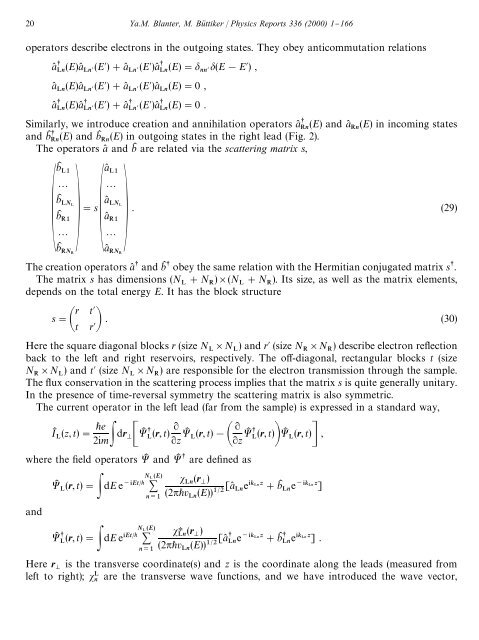shot noise in mesoscopic conductors - Low Temperature Laboratory
shot noise in mesoscopic conductors - Low Temperature Laboratory
shot noise in mesoscopic conductors - Low Temperature Laboratory
Create successful ePaper yourself
Turn your PDF publications into a flip-book with our unique Google optimized e-Paper software.
20 Ya.M. Blanter, M. Bu( ttiker / Physics Reports 336 (2000) 1}166<br />
operators describe electrons <strong>in</strong> the outgo<strong>in</strong>g states. They obey anticommutation relations<br />
a( (E)a( (E)#a( (E)a( (E)" (E!E) ,<br />
a( (E)a( (E)#a( (E)a( (E)"0 ,<br />
a( (E)a( (E)#a( (E)a( (E)"0 .<br />
Similarly, we <strong>in</strong>troduce creation and annihilation operators a( (E) and a( (E) <strong>in</strong> <strong>in</strong>com<strong>in</strong>g states<br />
and bK (E) and bK (E) <strong>in</strong> outgo<strong>in</strong>g states <strong>in</strong> the right lead (Fig. 2).<br />
The operators a( and bK are related via the scatter<strong>in</strong>g matrix s,<br />
bK<br />
<br />
2 2<br />
bK a(<br />
. (29)<br />
bK a(<br />
<br />
2 2<br />
bK a(<br />
"sa(<br />
<br />
The creation operators a( and bK obey the same relation with the Hermitian conjugated matrix s.<br />
The matrix s has dimensions (N #N )(N #N ). Its size, as well as the matrix elements,<br />
<br />
depends on the total energy E. It has the block structure<br />
r t<br />
s" . (30)<br />
t r<br />
Here the square diagonal blocks r (size N N ) and r (size N N ) describe electron re#ection<br />
<br />
back to the left and right reservoirs, respectively. The o!-diagonal, rectangular blocks t (size<br />
N N ) and t (size N N ) are responsible for the electron transmission through the sample.<br />
<br />
The #ux conservation <strong>in</strong> the scatter<strong>in</strong>g process implies that the matrix s is quite generally unitary.<br />
In the presence of time-reversal symmetry the scatter<strong>in</strong>g matrix is also symmetric.<br />
The current operator <strong>in</strong> the left lead (far from the sample) is expressed <strong>in</strong> a standard way,<br />
IK (z, t)"<br />
e<br />
2im dr K (r, t)<br />
R<br />
Rz K (r, t)! R<br />
Rz K (r, t) K (r, t) ,<br />
<br />
where the "eld operators K and K are de"ned as<br />
and<br />
K (r, t)" dE e<br />
<br />
<br />
K (r, t)" dE e<br />
<br />
<br />
(r )<br />
(2v (E)) [a( e#bK e]<br />
H (r )<br />
(2v (E)) [a( e#bK e] .<br />
Here r is the transverse coord<strong>in</strong>ate(s) and z is the coord<strong>in</strong>ate along the leads (measured from<br />
left to right); are the transverse wave functions, and we have <strong>in</strong>troduced the wave vector,
















